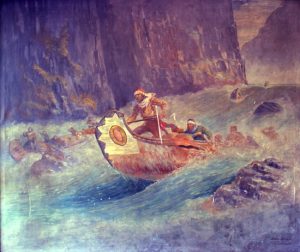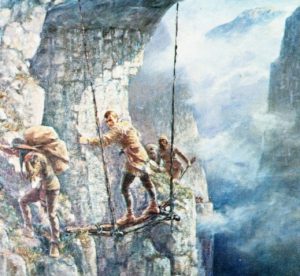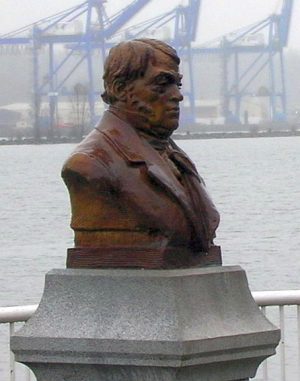#172 Highland Clearances to BC
First published September 18, 2017
REVIEW: The Nor’ Wester
by David Starr
Vancouver: Ronsdale Press, 2017.
$11.95
978-1-55380-493-2
Reviewed by Steve Pocock
David Starr’s The Nor’Wester, for young readers, introduces us to fifteen-year-old Duncan Scott, a young highlander evicted with his sister and parents from their rural cottage during the Highland Clearances in the early nineteenth century.
When the family must swap their farming life for the grim squalor of a one-room Glasgow tenement, Duncan and his family survive by working at a local cotton mill. The mill burns down with many of the workers, including Duncan’s parents, still inside.

When the “fat, toad-like” aristocratic English mill owner arrives to survey the destruction of his beloved factory, he cruelly derides Duncan’s parents as “useless Highland trash” and hits his sister Libby.
The story is told from Duncan’s viewpoint. Traumatized and reacting instinctively, Duncan strikes back and nearly kills the mill owner, forcing him and his sister to flee and head south.
Now a fugitive, he must evade the law and the gallows. His life changes forever when Libby sacrifices her freedom to allow Duncan to escape and make his way across the ocean to Canada and a new life.
Here he meets the fur trader Simon Fraser in what is now called British Columbia. Duncan accompanies him on his voyages of discovery with the North West Company in search of a trading route to the Pacific.
The adventures that follow are engagingly written in short chapters that will suit, and I think captivate, the intended audience. Starr skilfully inserts Duncan’s fictitious character into the lives of real historical characters and events to bring the past alive while providing a stimulating introduction to the explorations that brought colonial British Columbia into existence.

To emphasise Duncan’s roots, Starr liberally sprinkles overt Scotticisms throughout the text such as “A dinnae ken,” “fer sure,” and “nae lad.” As someone who has lived in Scotland, I initially found this slightly irritating, but by inserting myself into the shoes of young readers who may have had no exposure to Scottish culture, I found that it really does work. After a while, I could hear Duncan speaking in his Scottish lilt.
By adroitly imparting western and wider Canadian history throughout the novel, Starr may fire young imaginations and encourage them to delve deeper into the story of the soon-to-be-called British Columbia.
He also introduces the diversity of First Nation and Métis people encountered along the journey, according them a rightful prominence and importance within the story. The vital role of the legendary French Canadian voyageurs and their fabled canoe skills is well told.
I am ambivalent about the perpetuation of the stereotypical depiction of the “David and Goliath” relationship between the Scots and English as well as the traditional English “baddie” role. The English-accented bogeyman Cecil Hamilton comes across as an over-the-top pantomime villain; Duncan is portrayed as a courageous downtrodden underdog hero. This is too simplistic.

A more nuanced description of both characters and their interaction would still be appropriate for young readers.
Strangely, there is no physical description of Duncan throughout the book, which would have provided a more tangible attachment to the main character.
These minor issues aside, I found The Nor’Wester an enjoyable page-turner. It made me re-read several scholarly studies on B.C. history, especially those dealing with the North West Company’s important expeditions led by Simon Fraser, Alexander Mackenzie and David Thompson.
Starr’s humanizing description of the interpersonal relationships between his main characters creates a deeper appreciation of people and events described far less vividly in more academic works.
My forays into the fact-laden history books provided a wider spatial and temporal background to the characters developed by Starr. Although young readers may not read in this contextual manner, I’m certain The Nor’Wester will inspire a great many to learn more about British Columbia’s rich and colourful past, and I can readily recommend this satisfying and lively retelling of the Simon Fraser expedition.
 The Nor’Wester can only serve to bring a renewed interest to our province’s past to the younger generation — an exposure that may ultimately lead to new passions, research, and discoveries.
The Nor’Wester can only serve to bring a renewed interest to our province’s past to the younger generation — an exposure that may ultimately lead to new passions, research, and discoveries.
I hope that David Starr will consider it the first in a trilogy and write accompanying novels that bring to life the adventures of Alexander Mackenzie and David Thompson for younger readers.
*
 Steve Pocock is a researcher with Hansard Services at the Legislative Assembly of British Columbia. A graduate of St Andrews University, he and his wife immigrated to Canada in 2008 from North Yorkshire, where they lived for many years. Steve enjoys travel and languages and has a keen interest in the history of British Columbia. He has also been known to enjoy the craft beers that occur in such wonderful abundance in the province.
Steve Pocock is a researcher with Hansard Services at the Legislative Assembly of British Columbia. A graduate of St Andrews University, he and his wife immigrated to Canada in 2008 from North Yorkshire, where they lived for many years. Steve enjoys travel and languages and has a keen interest in the history of British Columbia. He has also been known to enjoy the craft beers that occur in such wonderful abundance in the province.
*
The Ormsby Review. More Readers. More Reviews. More Often.
Reviews Editor: Richard Mackie
Reviews Publisher: Alan Twigg — BC BookWorld / ABCBookWorld / BCBookLook / BC BookAwards / The Literary Map of B.C. / The Ormsby Review
The Ormsby Review is a new journal for serious coverage of B.C. literature and other arts. It is hosted by Simon Fraser University. The Advisory Board consists of Jean Barman, Robin Fisher, Cole Harris, Wade Davis, Hugh Johnston, Patricia Roy, David Stouck, and Graeme Wynn.
“Only connect.” – E.M. Forster